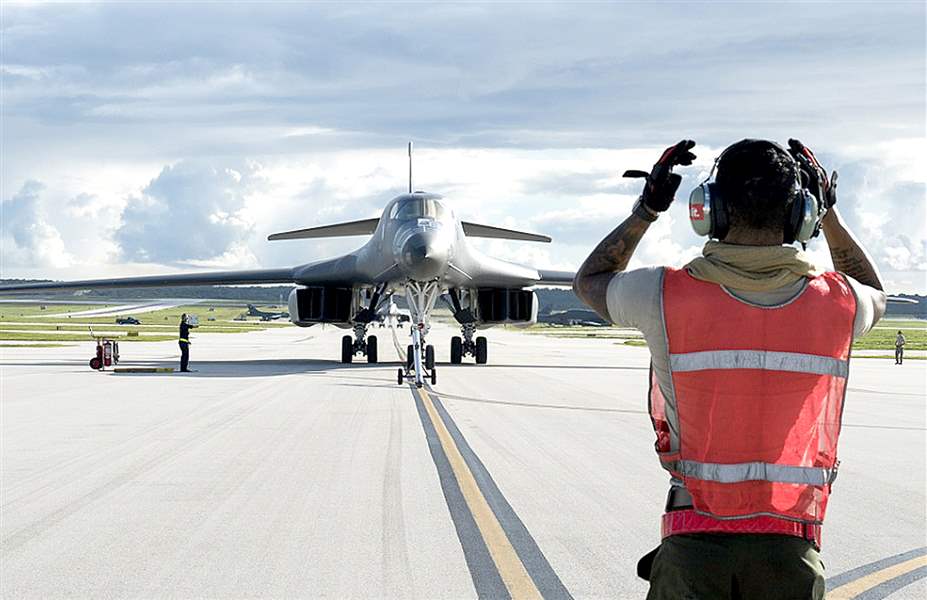
Trump, Kim exchange threats, but military holds calm posture
No shift in U.S. military footing evident
8/13/2017
A U.S. Air Force B-1B Lancer arrives at Andersen Air Force Base in Guam. Even as North Korea has threatened to fire missiles at the small American territory in the Pacific Ocean, the U.S. military does not appear to be preparing for an imminent war.
U.S. AIR FORCE
The U.S. military does not appear to be moving toward a wartime footing with North Korea despite President Trump’s repeated threats this week of military action against Pyongyang, with few if any additional military forces moving into the region and the Pentagon chief emphasizing diplomacy over bloodshed.
The military posture has effectively remained the same even as Mr. Trump said Friday that he hopes North Korean officials “fully understand the gravity of what I said” and that “those words are very, very easy to understand.”
But it appears Mr. Trump is still waging a rhetorical war rather than preparing to launch a military one.
Among the signals that a major U.S. operation is not imminent is a trip just under way by Marine Gen. Joseph Dunford Jr., the chairman of the Joint Chiefs of Staff, and a small cadre of his staff. He arrived Friday in Hawaii with plans to visit Japan, South Korea, and China, all of which would be in peril if a war between North Korea and the United States exploded.
The aircraft carrier USS Ronald Reagan and its accompanying flotilla of destroyers and guided-missile cruisers returned to port Wednesday in Yokosuka, Japan, the Navy announced. The ships and the thousands of U.S. service members aboard spent three months patrolling the region and could have stayed at sea off the coast of the Korean Peninsula if the Pentagon was preparing for near-term conflict.
Defense Secretary Jim Mattis and Secretary of State Rex Tillerson also have repeatedly sought to reduce tensions. Mr. Mattis, asked Thursday about Mr. Trump’s comments and what the death toll could look like in a nuclear confrontation, said that it was his job “to have military options should they be needed” but that he thought a diplomatic effort led by Mr. Tillerson and Nikki Haley, the U.S. ambassador to the United Nations, was gaining traction and should remain at the center of U.S. policy.
“I want to stay right there, right now,” said Mr. Mattis, who commanded troops in Iraq and Afghanistan as a Marine general before retiring. “The tragedy of war is well enough known. It doesn’t need another characterization beyond the fact that it would be catastrophic.”
Despite North Korea’s colorful and threatening rhetorical broadsides, there also are few signs that the country’s leader, Kim Jong Un, is spoiling for a fight that could lead to his ouster, and there has been no evacuation of American citizens from South Korea announced, said Michael Horowitz, a political-science professor and author at the University of Pennsylvania who studies military conflict.
“The U.S. is pre-positioned to respond to North Korean aggression on the peninsula all the time,” Mr. Horowitz said. “But what we are not seeing yet are true naval movements, family movements and troop movements that would suggest that the military is preparing for imminent conflict.”
The Pentagon has nearly 30,000 troops in South Korea to deter any North Korean attack and has kept at least 28,500 deployed there each year since an armistice agreement put a halt to fighting in the Korean War in 1953. They would almost certainly be the first into the fight if North Korea decided to launch an attack, and there is no indication that their operations have significantly changed.
The United States also keeps bombers and other military equipment on bases throughout the Pacific, including B-1B bombers on the U.S. island of Guam.
Pacific Command said in a tweet Friday that the aircraft are ready to carry out missions if called upon and Trump retweeted that message, but their availability is routine: Bombers have been deployed there on a rotational basis for years. The Pentagon still has some planes that can drop nuclear bombs, but none of them are stationed in the Pacific.
Marine Lt. Col. Christopher Logan, a Pentagon spokesman, declined to comment on whether major changes have occurred but said that U.S. forces in South Korea remain ready for any kind of attack.
Patrick Cronin, the senior director of the Asia-Pacific Security Program at the Center for a New American Security, said that despite Trump’s rhetoric, he doesn’t see a major shift in U.S. policy toward North Korea. The plan still appears to be to pressure Pyongyang to stop its nuclear weapons development and be prepared to respond overwhelmingly if they strike, Mr. Cronin said.
But Mr. Cronin — who said he discussed North Korea with White House officials this week — added that there is an important difference in Trump’s approach to Kim. By “turning up the brightness” on what was done in the past, Mr. Trump is still angling to put pressure on China to get North Korea to come to the negotiating table, Mr. Cronin said.
“This is the same policy, just amped up a bit,” he said. “We’re putting this through the Hollywood glitz here.”
Nonetheless, the stakes remain high and unpredictable, said Abraham Denmark, a former Obama administration official who worked on Asia issues at the Pentagon. It appears right now that “rhetoric seems to be far out front of the physical manifestation of our policy,” but the language used by world leaders can create unintended consequences, Mr. Denmark said.
For now, a particularly sensitive question will be the response if North Korea carries out its threat to test a missile that lands near Guam but does not hit the island.
“I’m sure,” Mr. Horowitz said, “that’s a question that people are working on in the Pentagon that we don’t quite know the answer to.”